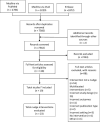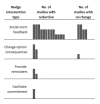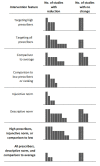Nudge interventions to reduce unnecessary antibiotic prescribing in primary care: a systematic review
- PMID: 36657758
- PMCID: PMC9853249
- DOI: 10.1136/bmjopen-2022-062688
Nudge interventions to reduce unnecessary antibiotic prescribing in primary care: a systematic review
Abstract
Objectives: Antibiotic prescribing in primary care contributes significantly to antibiotic overuse. Nudge interventions alter the decision-making environment to achieve behaviour change without restricting options. Our objectives were to conduct a systematic review to describe the types of nudge interventions used to reduce unnecessary antibiotic prescribing in primary care, their key features, and their effects on antibiotic prescribing overall.
Methods: Medline, Embase and grey literature were searched for randomised trials or regression discontinuity studies in April 2021. Risk of bias was assessed independently by two researchers using the Cochrane Effective Practice and Organisation of Care group's tool. Results were synthesised to report the percentage of studies demonstrating a reduction in overall antibiotic prescribing for different types of nudges. Effects of social norm nudges were examined for features that may enhance effectiveness.
Results: Nineteen studies were included, testing 23 nudge interventions. Four studies were rated as having a high risk of bias, nine as moderate risk of bias and six as at low risk. Overall, 78.3% (n=18, 95% CI 58.1 to 90.3) of the nudges evaluated resulted in a reduction in overall antibiotic prescribing. Social norm feedback was the most frequently applied nudge (n=17), with 76.5% (n=13; 95% CI 52.7 to 90.4) of these studies reporting a reduction. Other nudges applied were changing option consequences (n=3; with 2 reporting a reduction), providing reminders (n=2; 2 reporting a reduction) and facilitating commitment (n=1; reporting a reduction). Successful social norm nudges typically either included an injunctive norm, compared prescribing to physicians with the lowest prescribers or targeted high prescribers.
Conclusions: Nudge interventions are effective for improving antibiotic prescribing in primary care. Expanding the use of nudge interventions beyond social norm nudges could reap further improvements in antibiotic prescribing practices. Policy-makers and managers need to be mindful of how social norm nudges are implemented to enhance intervention effects.
Keywords: INFECTIOUS DISEASES; PRIMARY CARE; Public health; Quality in health care; Respiratory infections.
© Author(s) (or their employer(s)) 2023. Re-use permitted under CC BY-NC. No commercial re-use. See rights and permissions. Published by BMJ.
Conflict of interest statement
Competing interests: None declared.
Figures




References
-
- World Health Organization . Model List of Essential Medicines, 21st List. Geneva: WHO, 2019.
Publication types
MeSH terms
Substances
LinkOut - more resources
Full Text Sources
Medical
Miscellaneous
